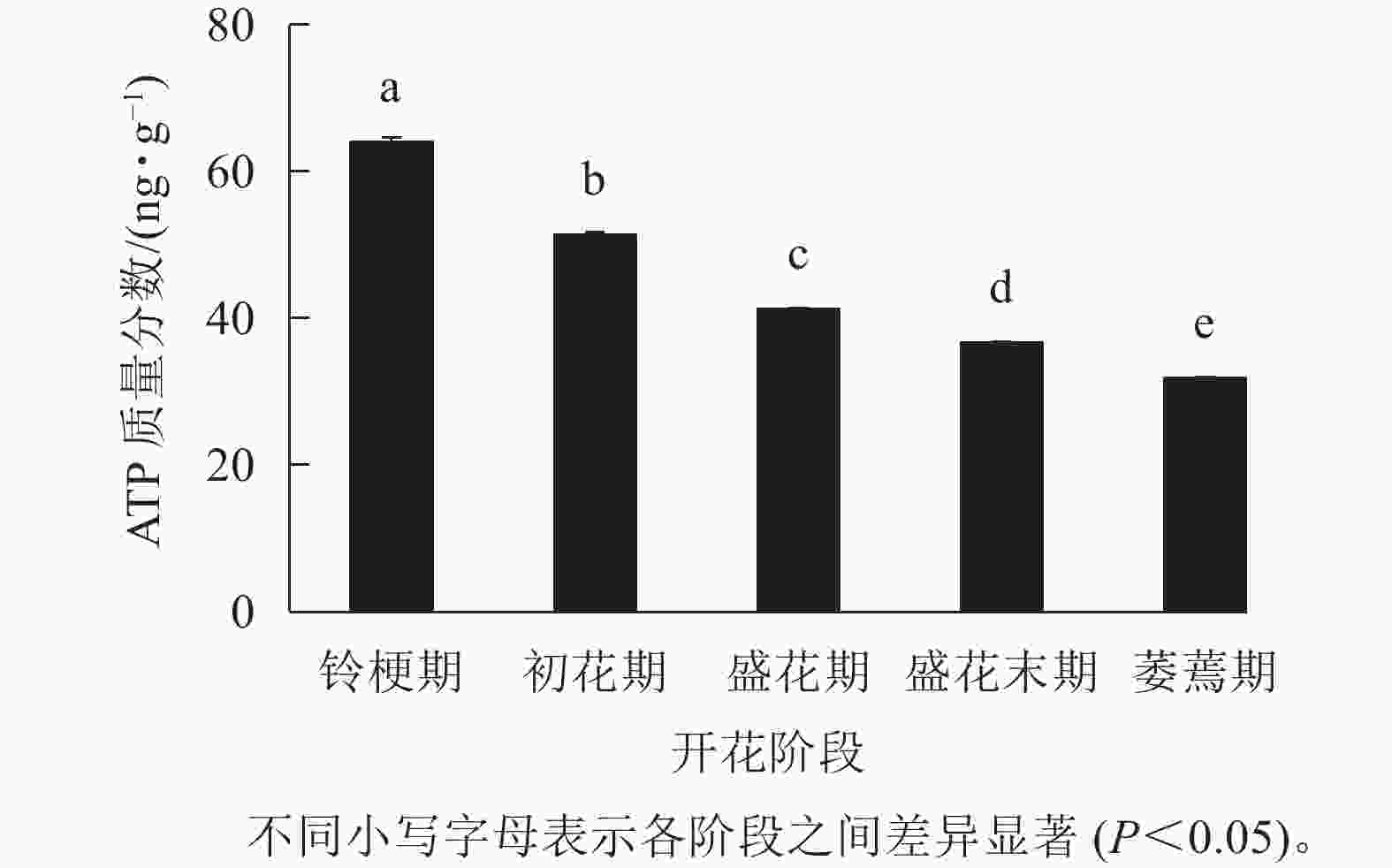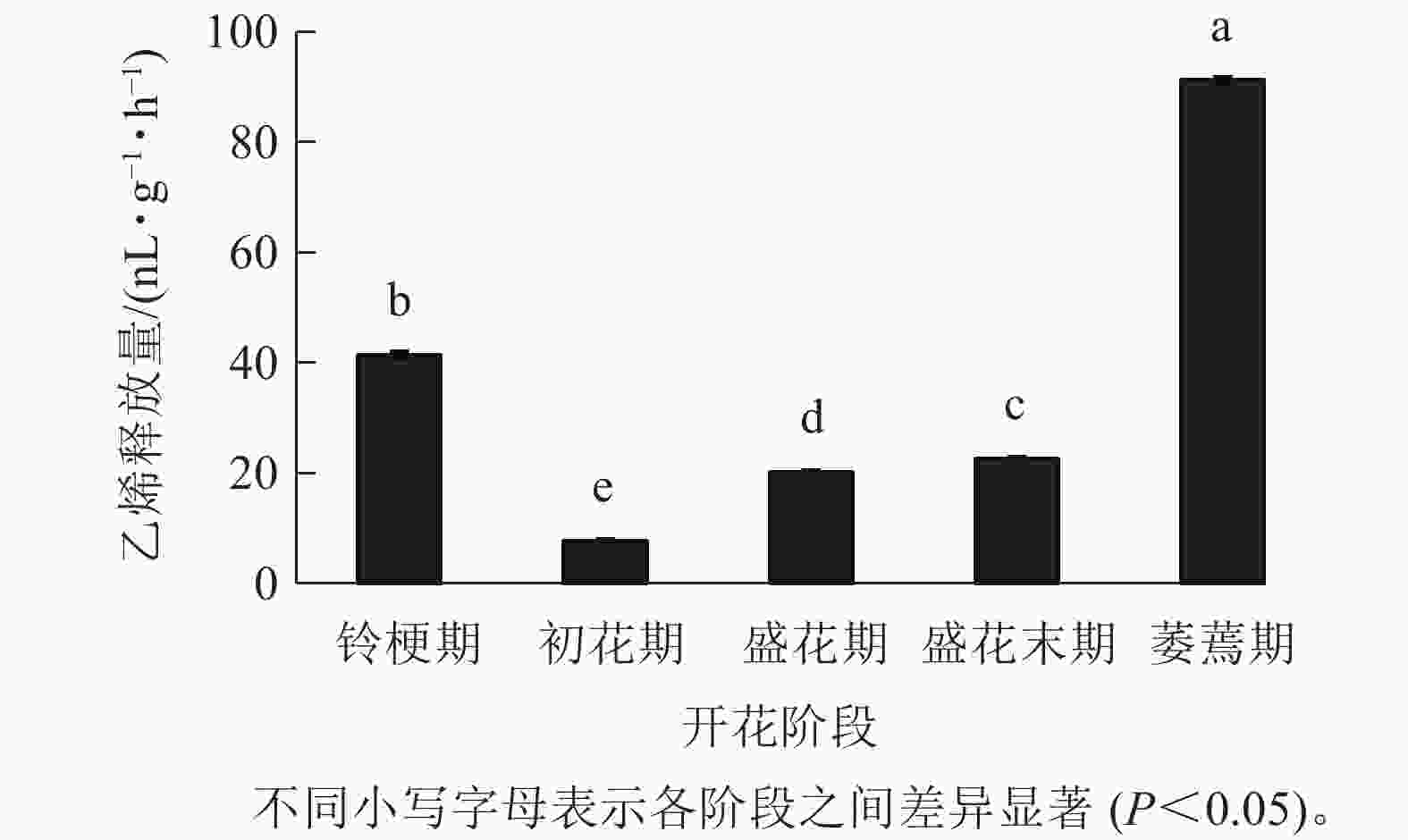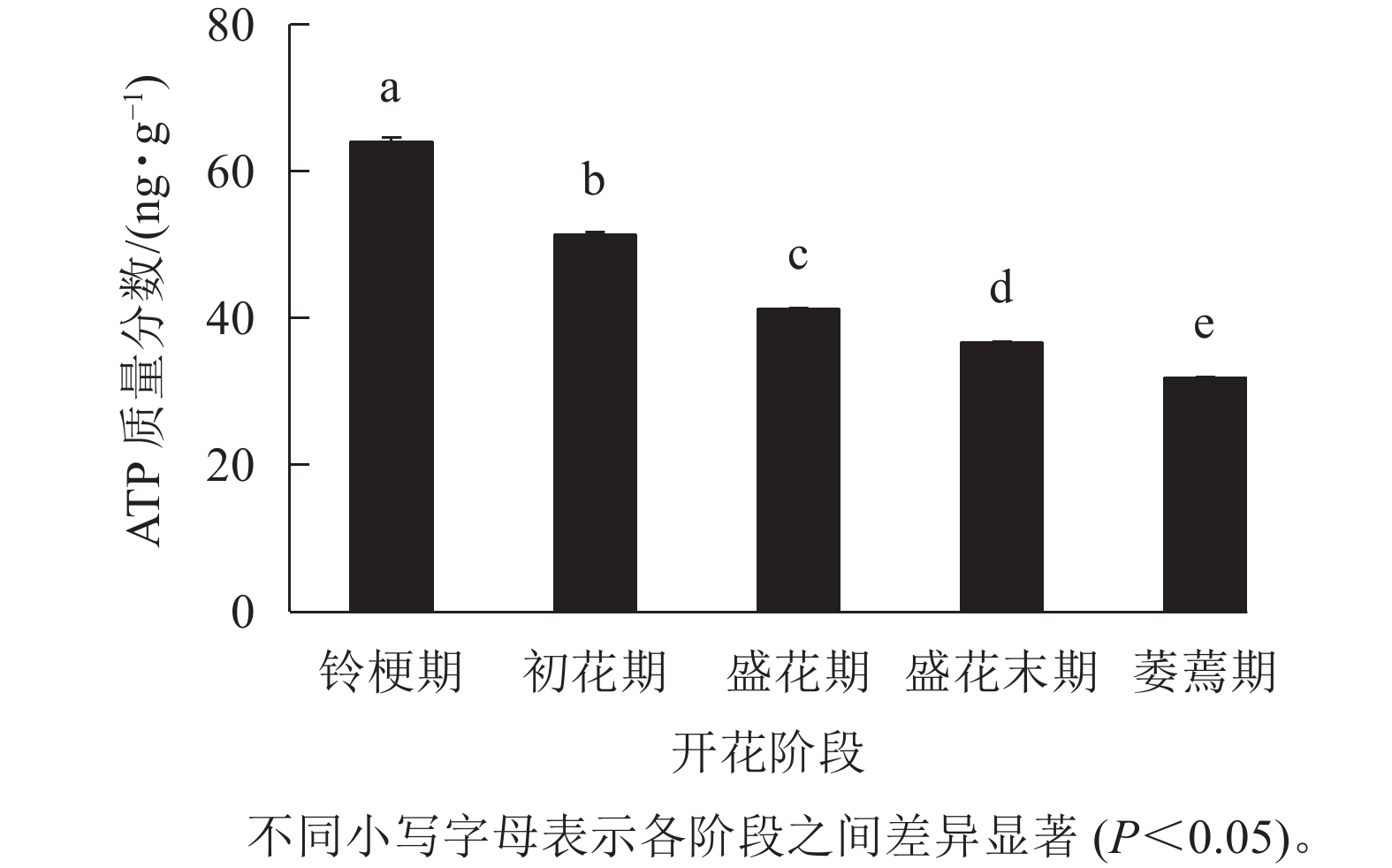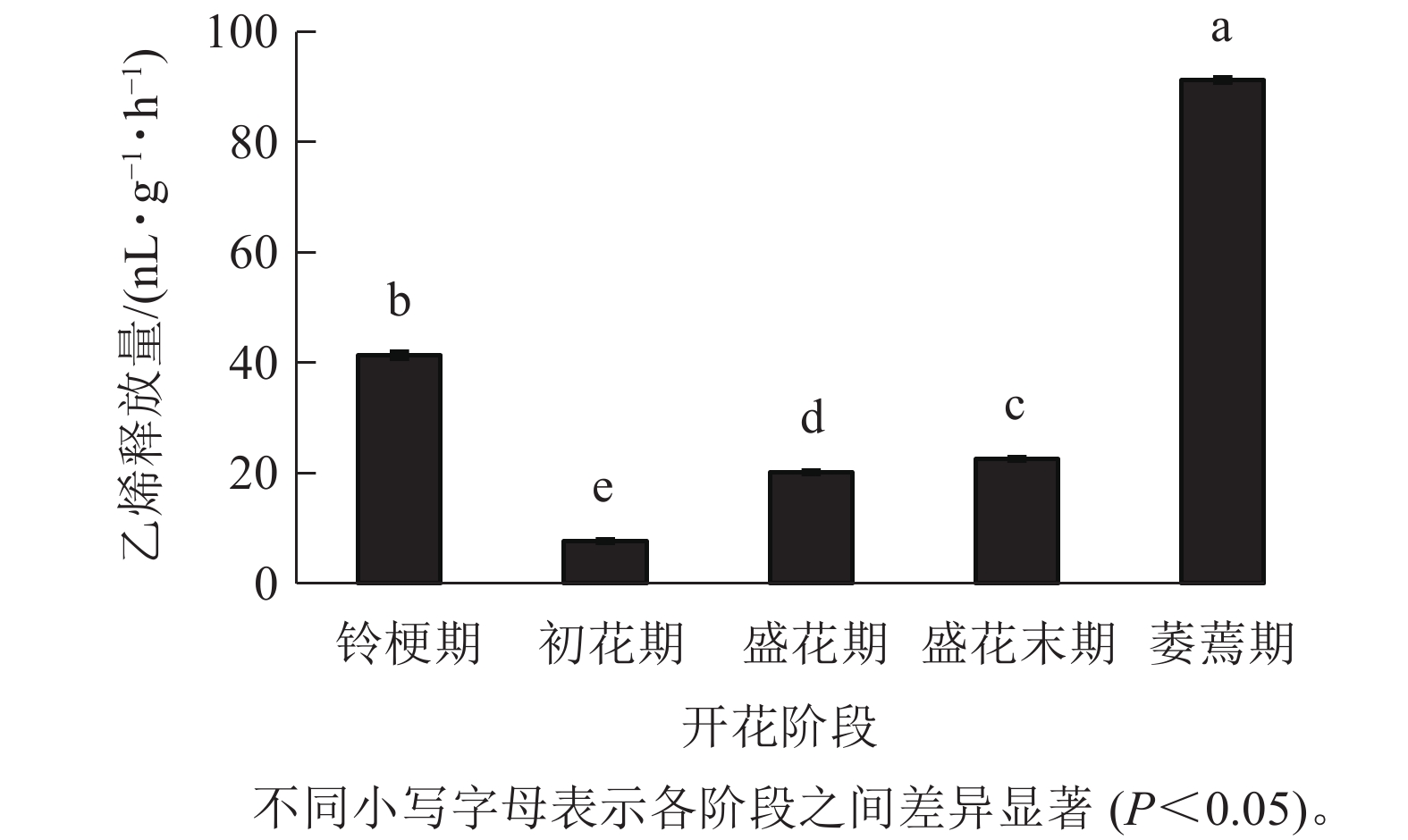-
桂花Osmanthus fragrans为木犀科Oleaceae园林观赏植物,是中国十大传统名花之一,自古享有“独占三秋压众芳”的美誉。其树姿优美,在园林中常用作行道树、孤植树;因香气浓郁,被列为中国重要的天然保健植物和特产经济香花植物,广泛用于食品添加剂及护肤品等产业。关于桂花茶、桂花(米)酒、桂花糕等鲜花采收加工产业已成熟,近年来新兴的桂花香水、乳液、香熏和精油等高档化妆品也逐渐打开市场[1−3]。然而,由于桂花花期较短,最佳观赏期和采收期仅2~3 d,极大地限制了其观赏价值与经济价值[4−5]。在目前记载的160多个桂花品种中,大部分由于雌蕊败育不结实,表现为开花后期脱落型;另一类为结实型桂花品种,开花后期花瓣表现为萎蔫,在树体不脱落[6]。前期研究发现:在不结实桂花品种‘柳叶金桂’O. fragrans ‘Liuye Jingui’的衰老过程中,当脱落期花瓣出现明显可见的衰老特征时,花瓣中DNA断裂迅速增加,衰老后期花瓣中出现染色质凝结等典型的细胞程序性死亡(PCD)现象[4, 7]。然而,对于结实型桂花衰老过程中的PCD特征还不清楚。因此,本研究以结实型桂花品种‘潢川金桂’O. fragrans ‘Huangchuan Jingui’为试材,探索结实型桂花花瓣衰老过程中PCD特征,为桂花花瓣衰老机制提供理论支撑。
-
选取华中农业大学校园内40~50年生、健康、无病虫害、四周光照均匀的‘潢川金桂’植株,分别采收不同开花阶段的桂花花朵,收集花瓣后称量,保存在冰盒或者液氮中,立即带回实验室,进行指标的检测并存至−80 ℃超低温冰箱备用。
-
参考ZOU等[4]桂花开花级数的划分体系,将 ‘潢川金桂’开花级数划分为:①铃梗期(花苞期),花朵呈紧闭的花苞状,未展开;②初花期,花朵微张,呈半开放状态;③盛花期,花瓣完全展开,柱头产生黄色黏性物时进行授粉,花径达到最大;④盛花末期,花瓣略微开始失水,有的花瓣伴随褐斑出现;⑤萎蔫期,花朵失水萎焉并留在树体上,花瓣呈黄褐色,子房略膨大。
-
参考ZOU等[4]的方法测定ROS质量摩尔浓度(nmol·g−1),参考林植芳等[8]的方法测定过氧化氢质量摩尔浓度(nmol·g−1)。称取新鲜花瓣组织0.2 g,按材料与提取液1∶1的质量比加入4 ℃下预冷丙酮和少许石英砂研磨成匀浆后,转入离心管10 000 r·min−1离心10 min,弃去残渣,上清液即为样品提取液。用Ti2(SO4)-浓氨水法制作过氧化氢标准曲线,取样品提取液1 mL用于反应测定。
-
参考ZOU等[5]的方法,以小鼠细胞色素c单克隆抗体(Merck & Co., Inc)作为一抗(1∶200稀释),用封闭液按1∶50 000稀释相应的HRP标记羊抗小鼠二抗。参照ZOU等[5]的方法,采用高效液相色谱法检测ATP质量分数(ng·g−1)。
-
参考ZOU等[4]的方法测定桂花乙烯释放量(nL·g−1)。
-
参考YAMADA等[9]的方法,采用流式细胞法测定不同衰老时期桂花花瓣中核含量(DNA团块)的变化。将桂花花瓣置于细胞核提取缓冲液中,将提取物通过50 μm尼龙网过滤,收集分离介质和DNA凝聚物,DAPI染色后,将溶液旋涡混合,用流式细胞仪分析从细胞核中分离出的DNA,计算并分析5 000个样品细胞中所含有核的DNA相对含量。流式细胞仪的仪器型号为BECKMAN COULTER (Cell Lab QuantaTM),仪器条件为:Ev 2.36;FL1 5.12、5.9;SS 5.12;5 000个细胞。
-
每处理3次生物学重复,数据为平均值±标准误。用SAS v.8.0.软件进行方差分析和多重比较分析(Duncan, P=0.05)。
-
在‘潢川金桂’桂花开花至衰老过程中,超氧阴离子质量摩尔浓度在初花期显著上升到最大值,为344.6 nmol·g−1,其后逐渐降低至200 nmol ·g−1(图1 A)。在‘潢川金桂’初花期花朵刚开放时,过氧化氢的质量摩尔浓度也显著地迅速上升到最大值,为437 nmol·g−1,此时过氧化氢质量摩尔浓度是花苞期的3倍。在随后衰老过程中,过氧化氢又下降到花苞期的水平(图1 B)。
-
如图2所示:从线粒体释放细胞质中的细胞色素c在初花和盛花期变得明显,表明此时已经发生了线粒体细胞色素c的泄漏;在盛花末期开始逐渐减弱,在萎蔫期的花瓣中则逐渐消失,可能与此时花瓣衰老细胞膜功能逐渐丧失有关。
-
如图3 所示:在‘潢川金桂’的铃梗期花瓣中测量到较高的ATP水平(63.9 ng·g−1),但随着花朵的开放至萎蔫期时,‘潢川金桂’花瓣中的ATP质量分数为31.8 ng·g−1,只有花苞期的一半。由此可见,在桂花花瓣衰老过程中ATP消耗或缺乏可能是PCD发生的早期信号。
-
在‘潢川金桂’开放及衰老过程中,乙烯释放量从盛花期开始逐渐上升;盛花末期花瓣出现可见的外观衰老特征时,其释放量显著增加到35.9 nL·g−1·h−1,而在萎蔫期时上升至最大值,为91.2 nL·g−1·h−1(图4),因此乙烯释放类型表现为典型的末期上升型,其释放量的增加可能与花瓣晚期PCD事件的发生相关。
-
如图5所示:DNA相对含量在开花早期相对稳定,而随着花瓣衰老进程的发展,核DNA相对含量逐渐降解,直到萎蔫期花瓣的核DNA基本消失,暗示着核DNA完全降解。
-
花瓣衰老标志着花朵生命的最后阶段,是发育相关的PCD[9]。PCD的诱发和执行过程都常常伴随一系列典型的生理、生化、形态学上的变化以及特征事件[10-11]。在动物细胞PCD进程中,ROS可以作为信号分子激活线粒体上非特异性的通透性孔道(PTP)开放[11-17],从而造成线粒体中细胞色素c和凋亡诱导因子(AIF)释放到细胞质中,而后细胞色素c与凋亡酶激活因子(Apaf-1)结合,从而促使细胞发生PCD[10]。在本研究中,‘潢川金桂’活性氧含量在初花期急剧增加,可能是桂花花瓣PCD早期诱导因子。作为线粒体中电子传递链的重要组成成分,细胞色素c泄露会导致电子传递链受阻,线粒体功能活性下降,从而导致ATP减少[18],最终加快花瓣衰老。在‘潢川金桂’花瓣衰老过程中,细胞质中细胞色素c逐渐积累,至盛花期达到最大,ATP水平从初花期开始持续下降,说明此时线粒体功能活性已逐渐丧失。在郁金香花瓣中,能量损耗也被认为是诱发细胞程序性死亡的早期信号[15]。
有些不结实的桂花栽培品种,盛花后2~3 d,在花瓣仍然具有膨压时便脱落[5-6];而在大多结实的桂花栽培种中,通常以花瓣萎蔫为衰老特征。乙烯是一种促进成熟与衰老的激素,也是导致花瓣发生细胞程序性死亡的因素之一,在促进DNA片段化、导致花瓣脱落和枯萎等方面发挥着作用[12]。研究表明:大多数植物的花瓣脱落都对乙烯敏感,且受到内源乙烯的调控[19-20]。在‘柳叶金桂’衰老过程中,乙烯的增加导致花瓣细胞中液泡结构损坏,在外观上表现为花瓣褐化和失水萎蔫[4]。也有研究发现:花瓣明显可见的萎蔫常常伴随着乙烯峰骤变,该乙烯骤变多又与授粉结实有关[21-23]。在本研究中,当结实型桂花品种‘潢川金桂’萎蔫期花瓣内乙烯释放量增加到最大值时,对应的外观形态上表现出枯萎、褐化,细胞内部发生核DNA的降解等现象,说明乙烯可能是导致结实型桂花花瓣衰老的主要执行因子。在月季Rosa × hybrida花瓣程序性死亡的研究中发现:施用外源乙烯可以诱导ACC基因的表达,促进内源乙烯的生物合成,从而加速PCD进程[24]。
DNA断裂和降解作为PCD发生的标志性特征之一[25],常表现出经典的“DNA ladders”,如唐菖蒲Gladiolus、六出花Alstroemeria和飞燕草Delphinium belladonna[9, 26-27];而有些植物衰老过程中并没有出现“DNA ladders”,如矮牵牛Petunia[28-29]。在‘柳叶金桂’的花瓣衰老过程中也未检测到“DNA ladders”,但通过原位末端标记法(TUNEL)发现:其花瓣在盛花末期开始发生明显的DNA断裂和降解;且其DNA降解受内源乙烯调控[4, 7]。在本研究中,花瓣衰老后期乙烯的骤变与后期DNA相对含量的下降,说明乙烯可能促进了“潢川金桂”花瓣DNA的降解,在矮牵牛[30]和豌豆Pisum sativum[31]中也有类似报道。
-
本研究探索了结实桂花品种‘潢川金桂’衰老的PCD特征,表明ROS激发、细胞色素c释放和ATP质量分数下降是早期PCD诱导因子;乙烯跃变可能作为晚期作用因子促进花瓣细胞的失水、萎蔫和DNA降解。
Programmed cell death events during the petal senescence of Osmanthus fragrans ‘Huangchuan Jingui’
doi: 10.11833/j.issn.2095-0756.20220782
- Received Date: 2023-01-03
- Accepted Date: 2023-03-08
- Rev Recd Date: 2023-02-27
- Available Online: 2023-05-22
- Publish Date: 2023-05-20
-
Key words:
- Osmanthus fragrans /
- programmed cell death /
- petal senescence /
- cytochrome c /
- adenosine triphosphate (ATP) /
- ethylene
Abstract:
| Citation: | HE Bei, CAI Xuan, ZENG Xiangling, et al. Programmed cell death events during the petal senescence of Osmanthus fragrans ‘Huangchuan Jingui’[J]. Journal of Zhejiang A&F University, 2023, 40(3): 475-480. DOI: 10.11833/j.issn.2095-0756.20220782 |















 DownLoad:
DownLoad:



